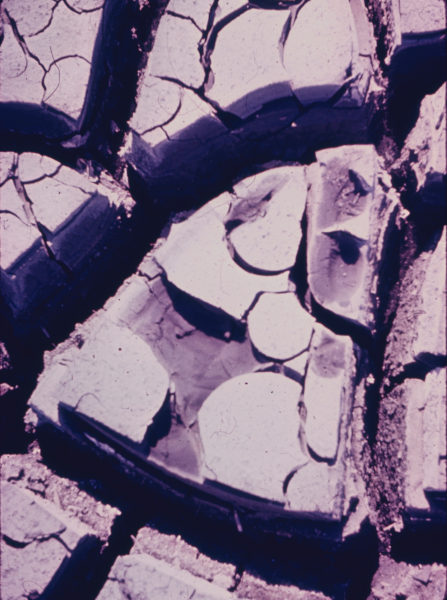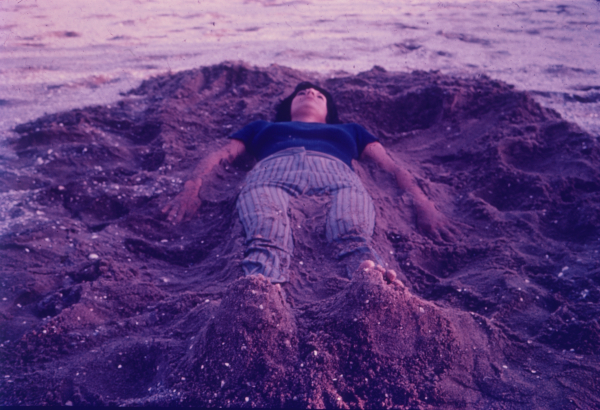Circumambulatio
Em latim, Circumambulatio quer dizer andar em torno de. Foi o título escolhido para dar nome ao trabalho desenvolvido por Anna Bella Geiger com um grupo de alunos do Setor de
Integração Cultural do Museu de Arte Moderna do Rio de Janeiro, em 1972. Classificada como um ambiente ou instalação, Circumambulatio é o que se chama na história da arte de obra
processual, ou seja, um trabalho vivo, resultado de uma ação que permanece em aberto, podendo sofrer modificações e acréscimos ao longo do tempo. A montagem apresentada aqui reúne as peças
(diapositivos, sons, fotografias e papéis manuscritos) que compuseram a versão original da instalação mostrada pela primeira vez, em 1972, no MAM RJ. No ano seguinte, por iniciativa de
Walter Zanini, então diretor do MAC USP, a obra foi exibida e comprada pela instituição. Essa é a primeira vez que o museu remonta a instalação, desde 1973.
Circumambulatio reúne textos e imagens sobre a necessidade humana de se organizar (no nível social e psíquico) em torno de um ponto de referência identificado com um centro. A obra foi
realizada em duas etapas. Num primeiro momento, Geiger e o grupo, formado por Abelardo Santos, Eduardo Escobar, Lígia Ribeiro e Suzana Geyerhahn, deixaram os ateliês de arte do MAM RJ para
trabalhar ao ar livre. Ao longo de três meses, ocuparam um terreno inóspito nos arredores da Lagoa de Marapendi, no bairro da Barra da Tijuca, onde fizeram desenhos diretamente sobre a
areia, com a ajuda de enxadas, de um trator, ou usando os próprios corpos. Suas ações efêmeras, de caráter abstrato e ritualístico, foram registradas pelo fotógrafo Thomas Lewinsohn. O
material deu origem a um audiovisual composto por 109 slides e uma gravação sonora contento textos de Carl Jung e da equipe, intercalados ao que havia de mais experimental na música
contemporânea – o trio inglês Emerson, Lake and Palmer, representante do rock progressivo, e a banda Can, pioneira do kraut rock alemão.
Em seguida, o grupo imergiu numa pesquisa bibliográfica e iconográfica intensa sobre ideia de centro, buscando referências nas artes, literatura, filosofia, história das religiões,
antropologia, arquitetura e nas ciências naturais. Carl Jung e Mircea Eliade são os autores mais citados. Além disso, os alunos de Geiger foram às ruas do Rio entrevistar transeuntes
sobre qual região da cidade representava um centro para eles. Os resultados das pesquisas foram reunidos num conjunto formado por 24 folhas em tamanho A1, contendo citações de autores
variados, e 20 fotografias em preto-e-branco (reproduções de obras de arte, imagens científicas, obras arquitetônicas e plantas de cidades). A instalação Circumambulatio é constituída por
este material, que podemos entender como um grande bloco de notas a ser compartilhado com o público, reunido ao audiovisual com fotos da Lagoa de Marapendi.
O trabalho marca um ponto de inflexão na trajetória de Anna Bella Geiger que, até meados dos anos 1960, dedicava-se ao abstracionismo. Resultado de pesquisas e vivências de caráter
altamente experimental, Circumambulatio representa também as mudanças ocorridas nas artes a partir dos anos 1960, um momento de questionamentos profundos sobre as linguagens artísticas,
as instituições museológicas, a ideia de autoria e o próprio conceito de arte. Embora com novas pautas, esses debates continuam prementes.
Heloisa Espada
Curadora
Circumambulatio
In Latin, Circumambulatio means "to walk around" This was the title of the work that Anna Bella Geiger developed in 1972 with a group of students from the Cultural Integration
Sector of the Museum of Modern Art of Rio de Janeiro. Classified as an environment or installation, Circumambulatio is what is known in art history as a processual work—, i.e. a living
work that emerges from an action that is open-ended and can undergo changes and additions over time. The installation shown here brings together the parts (slides, sound recordings,
photographs and handwritten papers) that made up the original version of the installation, which was first shown at the MAM RJ in 1972. The following year, on the initiative of Walter
Zanini, then director of MAC USP, the work was exhibited and acquired by the institution. This is the first time the museum has reassembled the installation since 1973.
Circumambulatio brings together texts and images about the human need to organize oneself (on a social and psychological level) around a reference point identified as the center. The work
was carried out in two phases. First, Geiger and the group, consisting of Abelardo Santos, Eduardo Escobar, Lígia Ribeiro and Suzana Geyerhahn, left the MAM RJ art studios to work outdoors.
For three months, they occupied an inhospitable area around the Lagoa de Marapendi in the Barra da Tijuca neighborhood, where they made drawings directly on the sand with the help of hoes,
a tractor or their own bodies. Their fleeting, abstract and ritualistic actions were recorded by photographer Thomas Lewinsohn. This material was used to create an audiovisual work
consisting of 109 slides and an audio recording with texts by Carl Jung and the team, accompanied by the most experimental contemporary music - the English trio Emerson, Lake and Palmer,
which stands for progressive rock, and the band Can, the pioneers of German Krautrock.
The group then immersed themselves in intensive bibliographical and iconographical research into the idea of the center, looking for references in art, literature, philosophy, the history
of religions, anthropology, architecture and the natural sciences. Carl Jung and Mircea Eliade are the most cited authors. In addition, Geiger's students took to the streets of Rio to ask
passers-by which region of the city they considered to be a center. The research results were compiled in a set of 24 A1-sized sheets with quotes from various authors and 20 black-and-white
photographs (reproductions of works of art, scientific images, architectural works and city maps). The installation Circumambulatio consists of this material, which can be understood as a
large notebook to be shared with the public, in combination with the audiovisual material with photos of Lagoa de Marapendi.
The work marks a turning point in the career of Anna Bella Geiger, who had devoted herself to abstractionism until the mid-1960s. The result of highly experimental research and experience,
Circumambulatio also reflects the changes in art from the 1960s onwards, a time when artistic languages, museum institutions, the idea of authorship and the very concept of art itself
were profoundly questioned. Although with new themes, these debates are still urgent.
Heloisa Espada
Curator
Galeria
Todas as imagens são reproduções de diapositivos da instalação Circumambulatio
Anna Bella Geiger
Circumambulatio, 1972-1973
fotografia pb, tinta de escrever e letra adesiva sobre papel,
diapositivo em cores 35 mm e fita magnética de 1/4 pol.
[versão digital para exibição: vídeo digital, som, cor, 10’]
Aquisição MAC USP
Fotografia: Thomas Lewinsohn















